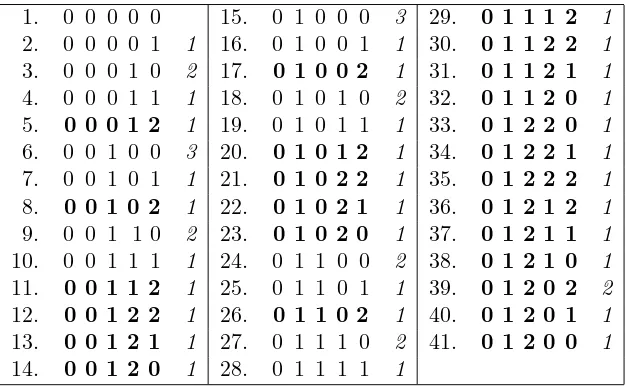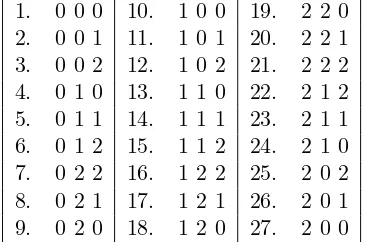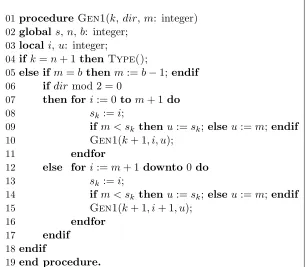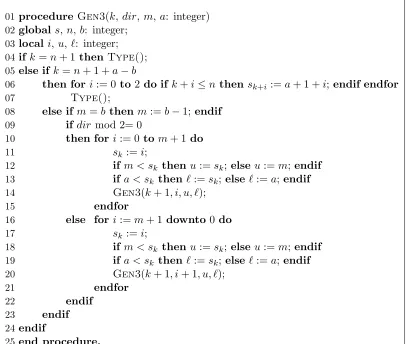arXiv:1703.05856v1 [math.CO] 17 Mar 2017
More restricted growth functions: Gray codes and exhaustive
generations
Ahmad Sabri1
and Vincent Vajnovszki2 1
Center for Computational Mathematics Studies, Gunadarma University [email protected]
2
LE2I, Universit´e Bourgogne Franche-Comt´e [email protected]
March 20, 2017
Abstract
A Gray code for a combinatorial class is a method for listing the objects in the class so that successive objects differ in some prespecified, small way, typically expressed as a bounded Hamming distance. In a previous work, the authors of the present paper showed, among other things, that the m-ary Reflected Gray Code Order yields a Gray code for the set of restricted growth functions. Here we further investigate variations of this order relation, and give the first Gray codes and efficient generating algorithms for bounded restricted growth functions.
Keywords: Gray code (order), restricted growth function, generating algorithm
1
Introduction
In [4] the authors shown that both the order relation induced by the generalization of the Binary Reflected Gray Code and one of its suffix partitioned version yield Gray codes on some sets of restricted integer sequences, and in particular for restricted growth functions. These results are presented in a general framework, where the restrictions are defined by means of statistics on integer sequences.
In the present paper we investigate two prefix partitioning order relations on the set of
2
Notation and definitions
A restricted growth function of length n is an integer sequence s=s1s2. . . sn with s1 = 0 and
0≤si+1 ≤max{sj}ij=1+1, for alli, 1≤i≤n−1. We denote byRnthe set of lengthnrestricted growth functions, and its cardinality is given by thenth Bell number (sequence A000110 in [6]), with the exponential generating function eex
−1. And length n restricted growth functions encode the partitions of ann-set.
For an integer b≥1, letRn(b) denote the set of b-boundedsequences in Rn, that is,
Rn(b) ={s1s2. . . sn∈Rn : max{si}ni=1 ≤b}, and
R∗
n(b) ={s1s2. . . sn∈Rn : max{si}ni=1 =b}. See Table 1 for an example.
1. 0 0 0 0 0 15. 0 1 0 0 0 3 29. 0 1 1 1 2 1
2. 0 0 0 0 1 1 16. 0 1 0 0 1 1 30. 0 1 1 2 2 1
3. 0 0 0 1 0 2 17. 0 1 0 0 2 1 31. 0 1 1 2 1 1
4. 0 0 0 1 1 1 18. 0 1 0 1 0 2 32. 0 1 1 2 0 1
5. 0 0 0 1 2 1 19. 0 1 0 1 1 1 33. 0 1 2 2 0 1
6. 0 0 1 0 0 3 20. 0 1 0 1 2 1 34. 0 1 2 2 1 1
7. 0 0 1 0 1 1 21. 0 1 0 2 2 1 35. 0 1 2 2 2 1
8. 0 0 1 0 2 1 22. 0 1 0 2 1 1 36. 0 1 2 1 2 1
9. 0 0 1 1 0 2 23. 0 1 0 2 0 1 37. 0 1 2 1 1 1
10. 0 0 1 1 1 1 24. 0 1 1 0 0 2 38. 0 1 2 1 0 1
11. 0 0 1 1 2 1 25. 0 1 1 0 1 1 39. 0 1 2 0 2 2
12. 0 0 1 2 2 1 26. 0 1 1 0 2 1 40. 0 1 2 0 1 1
13. 0 0 1 2 1 1 27. 0 1 1 1 0 2 41. 0 1 2 0 0 1
14. 0 0 1 2 0 1 28. 0 1 1 1 1 1
Table 1: The setR5(2), and in bold-face the setR∗5(2). Sequences are listed in≺·order (see Definition
2) and in italic is the Hamming distance between consecutive sequences.
If a list of same length sequences is such that the Hamming distance between successive sequences (that is, the number of positions in which the sequences differ) is bounded from above by a constant, independent on the sequences length, then the list is said to be a Gray code. When we want to explicitly specify this constant, sayd, then we refer to such a list as ad-Gray code; in addition, if the positions where the successive sequences differ are adjacent, then we say that the list is ad-adjacent Gray code.
The next two definitions give order relations on the set ofm-ary integer sequences of length
non which our Gray codes are based.
Definition 1. Letmand nbe positive integers withm≥2. TheReflected Gray Code Order≺ on{0,1, . . . , m−1}n is defined as: s=s
1s2. . . snis less thant=t1t2. . . tn, denoted bys≺t, if eitherPk−1
i=1 si is even andsk< tk, or Pk−1
This order relation is the natural extension to m-ary sequences of the order induced by the Binary Reflected Gray Code introduced in [2]. See for example [1, 4] where this order relation and its variations are considered in the context of factor avoiding words and of statistic-restricted sequences.
Definition 2. Letmandnbe positive integers withm≥2. Theco-Reflected Gray Code Order1 ≺·on{0,1, . . . , m−1}nis defined as: s=s
1s2. . . snis less thant=t1t2. . . tn, denoted bys≺·t, if
eitherUk is even andsk< tk, orUk is odd and sk> tk
for some k with si = ti (1 ≤ i≤ k−1) and sk 6= tk where Uk = |{i ∈ {1,2, . . . , k−1} :si 6= 0, si is even}|.
See Table 2 for an example.
For a set S of same length integer sequences the≺-first (resp. ≺-last) sequence in S is the first (resp. last) sequence when the set is listed in≺order; and≺·-firstand≺·-lastare defined in a similar way. And for sequenceu,u|S denotes the subset ofS of sequences having prefixu.
Both order relations, Reflected and co-Reflected Gray Code Order produce prefix partitioned lists, that is to say, if a set of sequences is listed in one of these order relations, then the sequences having a common prefix are consecutive in the list.
1. 0 0 0 10. 1 0 0 19. 2 2 0 2. 0 0 1 11. 1 0 1 20. 2 2 1 3. 0 0 2 12. 1 0 2 21. 2 2 2 4. 0 1 0 13. 1 1 0 22. 2 1 2 5. 0 1 1 14. 1 1 1 23. 2 1 1 6. 0 1 2 15. 1 1 2 24. 2 1 0 7. 0 2 2 16. 1 2 2 25. 2 0 2 8. 0 2 1 17. 1 2 1 26. 2 0 1 9. 0 2 0 18. 1 2 0 27. 2 0 0
Table 2: The set{0,1,2}3
listed in ≺·order.
3
The Gray codes
In this section we show that the setRn(b), withbodd, listed in≺order is a Gray code. However,
≺does not induce a Gray code whenb is even: the Hamming distance between two consecutive sequences can be arbitrary large for large enough n. To overcome this, we consider ≺· order instead of≺order when bis even, and we show that the obtained list is a Gray code.
In the proof of Theorem 1 below we need the following propositions which give the forms of the last and first sequence in Rn(b) having a certain fixed prefix, when sequences are listed in
≺order.
Proposition 1. Let b≥1 and odd, k≤n−2 and s=s1. . . sk. If t is the ≺-last sequence in s|Rn(b), then thas one of the following forms:
1. t=sM0. . .0 if Pk
i=1si is even and M is odd,
2. t=sM(M+ 1)0. . .0 if Pki=1si is even and M is even,
3. t=s0. . .0 if Pk
i=1si is odd,
where M = min{b,max{si}ki=1+ 1}.
Proof. Let t=s1. . . sktk+1. . . tn be the ≺-last sequence in s|Rn(b).
Referring to the definition of≺order in Definition 1, ifPki=1siis even, thentk+1 = min{b,max{si}ki=1+ 1}=M, and based on the parity ofM, two cases can occur.
• If M is odd, then we have that Pki=1si+tk+1 = Pki=1si+M is odd, thus tk+2. . . tn = 0. . .0, and we retrieve the form prescribed by the first point of the proposition.
• If M is even, then M 6= b and Pki=1si +tk+1 = Pki=1si +M is even, thus tk+2 = max{s1, . . . , sk, tk+1}+ 1 =M + 1, which is odd. Next, we have
Pk
i=1si+tk+1+tk+2 = Pk
i=1si+ 2M+ 1 is odd, and this implies as above thattk+3. . . tn= 0. . .0, and we retrieve the second point of the proposition.
For the case whenPki=1si is odd, in a similar way we have tk+1. . . tn= 0. . .0.
The next proposition is the ‘first’ counterpart of the previous one. Its proof is similar by exchanging the parity of the summation from ‘odd’ to ‘even’ and vice-versa, and it is left to the reader.
Proposition 2. Let b≥1 and odd, k≤n−2 and s=s1. . . sk. If tis the ≺-first sequence in s|Rn(b), then thas one of the following forms:
1. t=sM0. . .0 if Pk
i=1si is odd and M is odd,
2. t=sM(M+ 1)0. . .0 if Pk
i=1si is odd andM is even,
3. t=s0. . .0 if Pk
i=1si is even,
where M = min{b,max{si}ki=1+ 1}.
Based on Propositions 1 and 2, we have the following theorem.
Theorem 1. For any n, b≥1 and b odd, Rn(b) listed in ≺order is a 3-adjacent Gray code.
Proof. Let s=s1s2. . . sn and t=t1t2. . . tn be two consecutive sequences in≺ ordered list for
the setRn(b), withs≺t, and letkbe the leftmost position wheresandtdiffer. Ifk≥n−2, then obviouslys and tdiffer in at most three positions, otherwise let s′ =s1. . . s
k and t′ =t1. . . tk. Thus,sis the≺-last sequence ins′|R
n(b) andtis the≺-first sequence int′|Rn(b). Combining Propositions 1 and 2 we have that, when k≤n−3, sk+3sk+4. . . sn=tk+3tk+4. . . tn= 00. . .0. And since si=ti fori= 1. . . , k−1, the statement holds.
Proposition 3. Let b≥2 and even, k≤n−2 and s=s1s2. . . sk. If t is the ≺·-last sequence
in s|Rn(b), then thas one of the following forms:
1. t=sM0. . .0 if Uk+1 is even and M is even,
2. t=sM(M+ 1)0. . .0 if Uk+1 is even and M is odd,
3. t=s0. . .0 if Uk+1 is odd,
where M = min{b,max{si}ki=1+ 1} and Uk+1= Pk
i=1[si 6= 0 andsi is even].
Proof. Let t=s1. . . sktk+1. . . tn be the ≺·-last sequence in s|Rn(b).
Referring to the definition of≺·order in Definition 2, ifUk+1is even, thentk+1 = min{b,max{si}ki=1+ 1}=M >0, and based on the parity ofM, two cases can occur.
• IfM is even, thenUk+1+ [tk+1 6= 0 andtk+1 is even] =Uk+1+ 1 is odd, thustk+2. . . tn= 0. . .0, and we retrieve the form prescribed by the first point of the proposition.
• If M is odd, then M 6= b and Uk+1 + [tk+1 6= 0 and tk+1 is even] = Uk+1 is even, thus
tk+2 = max{s1, . . . , sk, tk+1}+ 1 =M + 1, which is even. Next, we have Uk+1+ [tk+1 6= 0 andtk+1 is even] + [tk+2 = 0 and6 tk+2 is even] = Uk+1+ 1 is odd, and this implies as above that tk+3. . . tn= 0. . .0, and we retrieve the second point of the proposition. For the case whenUk+1 is odd, in a similar way we havetk+1. . . tn= 0. . .0.
The next proposition is the ‘first’ counterpart of the previous one.
Proposition 4. Let b≥2 and even,k≤n−2 and s=s1s2. . . sk. If t is the ≺·-first sequence
in s|Rn(b), then thas one of the following forms:
1. t=sM0. . .0 if Uk+1 is odd and M is even,
2. t=sM(M+ 1)0. . .0 if Uk+1 is odd and M is odd,
3. t=s0. . .0 if Uk+1 is even,
where M = min{b,max{si}ki=1+ 1} and Uk+1=Pki=1[si 6= 0 andsi is even].
Based on Propositions 3 and 4 we have the following theorem, its proof is similar with that of Theorem 1.
Theorem 2. For anyn≥1, b≥2and even,Rn(b)listed in ≺·order is a3-adjacent Gray code. It is worth to mention that, neither ≺ for even b, nor ≺· for odd b yields a Gray code on
Rn(b). Considering b ≥ n in Theorem 1 and 2, the bound b does not actually provide any restriction, and in this caseRn(b) =Rn, and we have the following corollary.
Corollary 1. For any n≥1, Rn listed in both ≺ and ≺·order are 3-adjacent Gray codes. Theorem 3. For any b≥1 and odd, n > b, R∗
Proof. For two integersaandb, 0< a≤b, we defineτa,bas the lengthb−aincreasing sequence (a+ 1)(a+ 2). . .(b−1)b, and τa,b is vanishingly empty if a = b. Imposing to a sequence s in Rn(b) to have its largest element equal to b (so, to belong to R∗n(b)) implies that either b occurs in s before its last position, or sends with b, and in this case the tail of s is τa,b for an
appropriate a < b. More precisely, in the latter case, s has the form s1s2. . . sjτa,b, for some j
and a, witha= max{si}ji=1 and j =n−(b−a).
Now let s =s1s2. . . sn ≺t=t1t2. . . tn be two consecutive sequences in the ≺ ordered list
forR∗
n(b), and let k≤n−3 be the leftmost position where s and tdiffer, thus s1s2. . . sk−1 =
t1t2. . . tk−1. It follows that sis the ≺-last sequence inR∗n(b) having the prefix s1s2. . . sk, and using Proposition 1 and the notations therein, by imposing that max{si}ni=1 is equal to b, we have:
• if Pki=1si is odd, then shas the form s1s2. . . sk0. . .0τa,b, wherea= max{si}ki=1, • if Pki=1si is even, then shas one of the following forms:
– s1s2. . . skM0. . .0τM,b, or
– s1s2. . . skM(M + 1)0. . .0τM+1,b.
When the aboveτ’s suffixes are empty, we retrieve precisely the three cases in Proposition 1. Similarly, tis the≺-first sequence inR∗n(b) having the prefixt1t2. . . tk−1tk=s1s2. . . sk−1tk.
Since by the definition of≺order we have thattk=sk+ 1 ortk=sk−1, it follows thatPki=1ti and Pki=1si have different parity (that is,Pki=1ti is odd if and only ifPki=1si is even), and by Proposition 2 and replacing for notational convenienceM by M′, we have:
• if Pki=1si is odd, then thas the formt1t2. . . tk0. . .0τa′,b, wherea′= max{ti}ki=1,
• if Pki=1si is even, then thas one of the following forms: – t1t2. . . tkM′0. . .0τM′,b, or
– t1t2. . . tkM′(M′+ 1)0. . .0τM′+1,b.
With these notations, since tk∈ {sk+ 1, sk−1}, it follows that
• ifPki=1si is odd, thena′ ∈ {a−1, a, a+ 1}, and so the length ofτa,band that ofτa′,bdiffer by at most one; and
• if Pki=1si is even, then M′ ∈ {M−1, M, M + 1}, and the length of the non-zero tail of s and that of t(defined by means ofτ sequences) differ by at most two.
Finally, the whole sequencessandtdiffer in at most five (not necessarily adjacent) positions,
and the statement holds.
4
Generating algorithms
• Each recursive call either generates an object or produces at least two recursive calls;
• The amount of computation in each recursive call is proportional to the degree of the call (that is, to the number of subsequent recursive calls produced by current call).
Procedure Gen1 in Fig. 1 generates all sequences belonging to Rn(b) in Reflected Gray Code Order. Especially when b is odd, the generation induces a 3-adjacent Gray code. The boundb and the generated sequences=s1s2. . . sn are global. Thek parameter is the position where the value is to be assigned (see line 8 and 13); thedir parameter represents the direction of sequencing forsk, whether it is up (when dir is even, see line 7) or down (when dir is odd, see line 12); and m is such that m+ 1 is the the maximum value that can be assigned to sk, that is, min{b−1,max{si}ki=1−1}(see line 5).
The algorithm initially sets s1 = 0, and the recursive calls are triggered by the initial call
Gen1(2,0,0). For the current position k, the algorithm assigns a value to sk (line 8 or 13) followed by recursive calls in line 10 or 15. This scheme guarantees that each recursive call will produce subsequent recursive calls until k =n+ 1 (line 4), that is, when a sequence of length
n is generated and printed out by Type() procedure. This process eventually generates all sequences in Rn(b). In addition, by construction, algorithm Gen1 satisfies the previous CAT desiderata, and so it is en efficient exhaustive generating algorithm.
01procedure Gen1(k,dir,m: integer)
02globals,n,b: integer;
03locali,u: integer;
04ifk=n+ 1thenType();
05else if m=bthen m:=b−1;endif
06 if dir mod 2 = 0
07 then for i:= 0 tom+ 1do
08 sk:=i;
09 if m < sk then u:=sk;elseu:=m;endif
10 Gen1(k+ 1, i, u);
11 endfor
12 else for i:=m+ 1downto0 do
13 sk:=i;
14 if m < sk then u:=sk;elseu:=m;endif
15 Gen1(k+ 1, i+ 1, u);
16 endfor
17 endif
18endif
19end procedure.
Figure 1: Reflected Gray Code Order generating algorithm forRn(b); it produces a 3-Gray code whenb
is odd.
Finally, algorithmGen3in Fig. 3 generates the setR∗
n(b) in Reflected Gray Code Order and produces a 5-Gray code if b is odd. It mimes algorithm Gen1 and the only differences consist in an additional parameter a and lines 5, 6, 13 and 19, and its main call is Gen3(2,0,0,0). Parameter akeeps track of the maximum value in the prefix s1s2. . . sk−1 of the currently gen-erated sequence, and it is updated in lines 13 and 19. Furthermore, when the current position
k belongs to a τ-tail (see the proof of Theorem 3), that is, conditionk =n+ 1 +a−b in line 5 is satisfied, then the imposed value is written in this position, and similarly for the next two positions. Theorem 3 ensures that there are no differences between the current sequence and the previous generated one beyond position k+ 2, and thus a new sequence inR∗
n(b) is generated. And as previously, Gen3is a CAT generating algorithm.
procedure Gen2(k,dir,m: integer) globals,n,b: integer;
locali,u: integer;
ifk=n+ 1thenType();
else if m=bthen m:=b−1;endif if dir mod 2= 0
then for i:= 0to m+ 1do
sk:=i;
ifm < sk then u:=sk;elseu:=m;endif ifsk= 0 thenGen2(k+ 1,0, u);
elseGen2(k+ 1, i+ 1, u); endif
endfor
else for i:=m+ 1 downto0do
sk:=i;
ifm < sk then u:=sk;elseu:=m;endif if sk= 0 then Gen2(k+ 1,1, u);
else Gen2(k+ 1, i, u); endif
endfor endif
endif
end procedure.
Figure 2: Co-Reflected Gray Code Order generating algorithm forRn(b); it produces a 3-Gray code when
bis even.
Final remarks. We suspect that the upper bounds 3 in Theorems 1 and 2, and 5 in Theorem 3 are not tight, and a natural question arises: are there more restrictive Gray codes for Rn(b) and for R∗
n(b) with b odd? Finally, is there a natural order relation inducing a Gray code on
R∗
01procedure Gen3(k,dir,m,a: integer)
02global s,n,b: integer;
03local i,u,ℓ: integer;
04if k=n+ 1 thenType();
05else if k=n+ 1 +a−b
06 then fori:= 0to2 do if k+i≤nthen sk+i :=a+ 1 +i;endif endfor
07 Type();
08 else ifm=bthen m:=b−1;endif
09 ifdir mod 2= 0
10 then for i:= 0tom+ 1 do
11 sk :=i;
12 ifm < sk thenu:=sk; elseu:=m;endif
13 ifa < sk then ℓ:=sk;else ℓ:=a;endif
14 Gen3(k+ 1, i, u, ℓ);
15 endfor
16 else for i:=m+ 1downto0do
17 sk :=i;
18 ifm < sk thenu:=sk; elseu:=m;endif
19 ifa < sk then ℓ:=sk;else ℓ:=a;endif
20 Gen3(k+ 1, i+ 1, u, ℓ);
21 endfor
22 endif
23 endif
24endif
25end procedure.
Figure 3: Generating algorithm for R∗
n(b), n > b ≥ 1, with respect to Reflected Gray Code Order; it
produces a 5-Gray code whenbis odd.
References
[1] A. Bernini, S. Bilotta, R. Pinzani, A. Sabri, V. Vajnovszki, Reflected Gray codes for q-ary words avoiding a given factor, Acta Informatica, 52(7), 573-592 (2015).
[2] F. Gray, Pulse code communication, U.S. Patent 2632058 (1953).
[3] F. Ruskey, Combinatorial generation, Book in preparation.
[4] A. Sabri, V. Vajnovszki, Reflected Gray code based orders on some restricted growth se-quences, The Computer Journal, 58(5), 1099-1111 (2015).
[5] A. Sabri, V. Vajnovszki, Bounded growth functions: Gray codes and exhaustive generation, The Japanese Conference on Combinatorics and its Applications, May 21-25, 2016, Kyoto, Japan.
[6] N.J.A. Sloane, The On-line Encyclopedia of Integer Sequences, available electronically at




